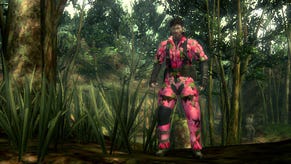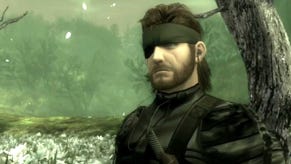Metal Gear Solid 3: Snake Eater
We're still in a dream.
Order yours now from Simply Games.
Have you ever woken up from a dream after a heady night out, and realised that...
Actually, if we're heading down that road, let's have a small caveat: Metal Gear Solid 3 really happens. You don't get to the end and discover it didn't. It's not the Military Matrix. For some people, approaching this one with a sense of trepidation absent from their initial reception of 2001's Sons of Liberty, but long since ingrained as a result of it, knowing that the illusion isn't about to descend into self-mutilation in search of a new twist or turn is crucial. With that in mind, let's try again.
Have you ever woken up from a dream after a heady night out, and realised that, while the embers of the dying fires of your accumulated affection for it still glow with fond recollections of love and intrigue, the journey itself would have been just as memorable without your contribution? Have you ever looked back on something brilliant that you technically did and felt like it would have happened anyway?
Snake in the grass
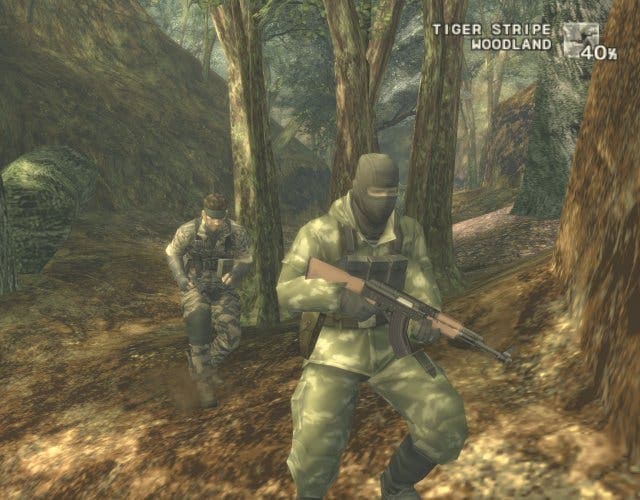
Metal Gear Solid 3 can feel like that. It can, and people will tell it off for doing so, but it doesn't have to. The trick is making the transition from post-millennial super-sleuthing to Cold War jungle espionage and not just relying on your old tricks. They won't work. Before, you snuck around, a third-person spy with a tranq gun, watching for enemies on the infamous radar and then either avoiding them by hiding (in a locker, behind a wall, dangling from a ledge) long enough for a gap to emerge in their lines, or taking them out somehow (dart, bullet, neck-snap, set-piece) if they became alert to your presence. You relied on knowing where enemies were, and letting your foreknowledge of their awareness and positioning dictate whether you tried to thread the needle without touching the sides by galloping straight for the door, or whether you had to leave them in an unconscious heap in some dark corner.
But this is 1964. We're in a jungle in Russia. Your fancypants radar hasn't been invented yet, which completely alters the way you approach your path - ever-linear, but not damagingly so - through the jungle. And initially you won't know what to do about that, as even the instructions and extensive briefings delivered by your colleagues are powerless to convey the logic of your new maze. It's entirely possible, we should think, to play through the entire game without learning how to do it "properly", and, if you do, by the end you'll find the cut-scenes alone are keeping you going, and you'll pop up on instant messenger when people ask you about the game and regurgitate your prized gag, fashioned over the course of replaying the same section - badly - over and over again for hours, and yet still loving the confounded game for maddeningly intangible reasons: "People keep asking me if you can skip the cut-scenes, but I just wanted to skip the gameplay. Hur hur!"
Retune your brain to the jungle though and the experience is arguably more flexible, engaging and memorable than either of its predecessors. The radar is gone, but like a blind man recently robbed of his sight you'll learn to compensate and approach things in new ways. And new ways are what sequels should be coming up with, no? You'll come to rely on the sonar, motion detector, anti-personnel sensor, directional microphone and thermal goggles (in a log in a clearing; trust us, you'll need them), and you'll become intimately familiar with concepts like the "Camouflage Index", a clever and by no means convoluted means of disguising yourself in what you'd imagine would be plain view, and Close Quarters Combat, a system for turning enemies into human shields, human tips hotlines, human juggling balls, or human chopping boards.
Jungle hook
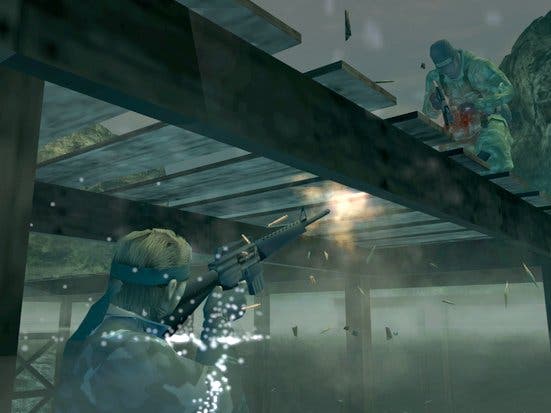
As you start to realise what it is you're meant to do to survive in the jungle, the experience of actually playing Metal Gear Solid 3 suddenly becomes just as important to you as the events that are unfolding in the story - ever the mainstay of the series and just as vital here. You - the classic "Snake", although you are given a choice what sort of hero you want to control - are parachuted with typical spy-pomp into a jungle in Russia and tasked with retrieving a Russian scientist from incarceration in a rundown factory. He wants to defect, and he's working on something very big for the Russians. But, between you and your quarry, there are a number of AK-47-toting goons patrolling under the canopies, circling a jungle floor peppered with patches of long grass, hollowed trunks, climbable trees, swampy undergrowth and even a Temple Of Doom-style rope bridge. Not to mention the crumbling masonry of the factory itself. And if you try to get to him without sufficiently acclimatising yourself, you'll get very cross. Very cross indeed.
But then if you try to do it the way you were meant - however unintuitive it may feel to begin with - you'll feel very differently. Crawl into the long grass and glance at the top right of the screen and you'll see a percentage figure; this tells you how well covered you are, and depending on the difficulty level there'll be a cut-off point above which guards will only be able to spot you if you move or they come into physical contact with you. Visit the Camouflage section of the pause menu and you'll discover a choice of outfits and face paint with plusses and minuses next to them; these tell you how many percentage points the garment or facial daub in question will add or subtract from your camouflage total. Whack on some leafy threads and take it up to 90 per cent and you're well covered.
But then that's the easy bit. Everyone gets that, and quickly. The real trick is working out where your enemies are without alerting them - and as your default camera remains a slightly off-kilter top-down third-person affair, and your first-person view is so often obscured by the grass or other bits of the jungle, you can't rely on your lying eyes to plot a course. Even though you can see a bit further in any given direction by dragging the right thumb-stick around, you're going to have to dig into your backpack for tools. Pull out a sonar and you can ping signals off your surroundings, and although it'll mix up animals with humans - and there are plenty of other sentient creatures sharing the jungle environment - and the noise will be loud enough for any guards standing close by to notice, it will give you an idea of where people are. Likewise the thermal goggles, the microphone, the motion detector, et al. All rely on batteries, which recharge when they're not in use, but all will get a lot of use if you plan to make it through unscathed - or at least without a vast mountain of luck.
I, spy
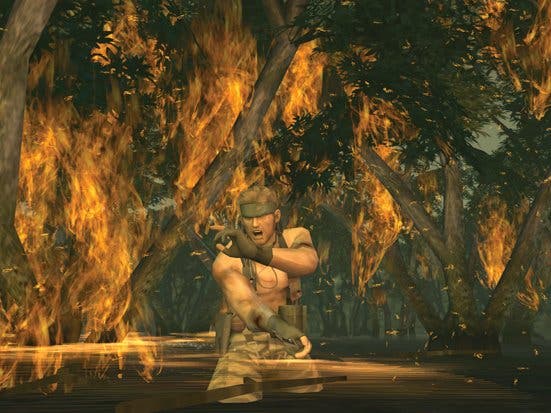
However, what can be particularly frustrating for people not yet into the swing of being the Jungle VIP is what happens when you can't help but being seen. There are plenty of places to hide, but few of them get you out of sight long enough for the trail to go dead - particularly outside where guards converge on you from all directions and seem to have no trouble finding you - even after you've dived into the undergrowth wearing your best Mr. Invisible pants. Hiding in the grass is only good up to the point that they tread on your head and realise where to stick their weapons, after all. Get to know your Close Quarters Combat (CQC) though and your chances greatly improve. You can grab an enemy from any direction by pressing circle, and make a human shield out of them, interrogate them for things like door codes, throw them down, or even slit their throat - all of which is conveyed by a flurry of twisting arms and judo-like body movements.
When you get used to all that, the dynamic feels considerably different - and yet familiar enough that it's a comfort. You're actually a better spy, and you feel like one.
Meanwhile the backpack, mentioned in passing earlier, deserves some explanation of its own, and leads us on to a triumvirate of critical changes to the way Snake deals with his own well-being. Along the top-left of the screen you see Snake's health and stamina bars. Previously, you topped the former up by locating rations and then using them at an opportune moment - or having them automagically kick in like a safety net when you're on your last legs by leaving them permanently equipped. Here though, it's a different deal. Stamina, first, dictates how fast you can move, the accuracy of your aiming, and even whether you can see properly (at one point we thought night was closing in, but it only was in a figurative sense), and it's this ever-decreasing total that your ration-style foodstuffs will subsidise. And instead of finding food when you shake the bodies of downed guards or rustle around storerooms, you'll have to create much of it on your own by shooting snakes, fruit, mushrooms and even crocs and then picking up the ration boxes they morph into.
Dinner time
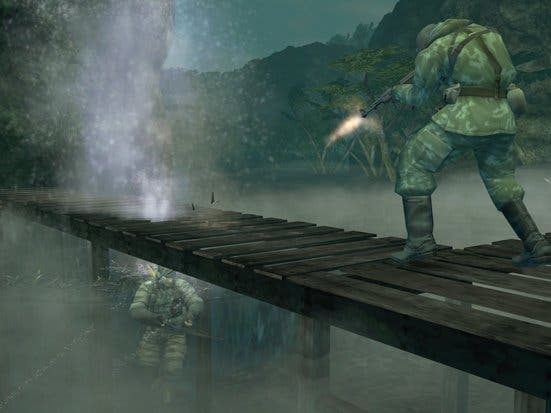
Keeping up your stamina is important, then, because you can't always stop shooting to go and turn on the oven, and if you happen to run low in a firefight with nothing edible in your backpack then you're finished. Not least of all because you can barely see and you're running with all the pace of Socrates' recent outing for non-league outfit Garforth Town. Sorry, football reference. So that's: with all the pace of a 50 year-old Brazilian lifelong smoker trying to sprint across an icy field on a cold winter's morning in Yorkshire. And one of the ways you can avoid running your batteries down, to come full circle, is to make sure you travel relatively light - and keep things in your backpack when they're not needed. Everything in the game has a set weight, and by the time you're hauling a few assault rifles, knives, sensors and tools around it can noticeably trouble your stamina bar unless you stow them.
Food does stamina, but how do we recover health? Simple. Keep your stamina up. Seriously. Do that and as long as you can stay out of harm's way your health will recharge. What you really have to worry about is wounds. Take a bullet in the leg, for example, and it'll stay there, and it'll reserve its own little red blob of your health bar, which cannot be refilled until the bullet's removed and the wound dressed. Suddenly you have another priority - medical supplies. With these you can go into the "Cure" screen in the pause menu and treat your injuries, wrapping fractured limbs in splints and bandages, using a knife to prise out a bullet and then disinfecting, sewing and bandaging it, or smearing yourself in ointment to treat searing burns. Keeping up a decent stock of supplies becomes crucial later on.
With so many new techniques and ideas at your disposal, there are a seemingly infinite number of ways to approach given scenarios - and MGS3 gives you a lot of scenarios to approach. Far more than MGS2, and with far less repetition. As well as covering ground in the jungle, you'll have to sneak through barracks-like encampments, working your way through trenches and past electric fences, stealing into military research compounds and disguising yourself as a scientist and a soldier, work your way down a mountainside pursued by flame-throwing soldiers, and in one memorable passage of play you also have to affect your own amphibious assault by wading through swampland - avoiding the attentions of the hover-drone fellows pottering above the mangroves - and tackling guards creeping around a series of jetties in front of a warehouse by hiding under boats, dragging bodies into the depths and making judicious use of your ability to swim underwater.
Take a look around
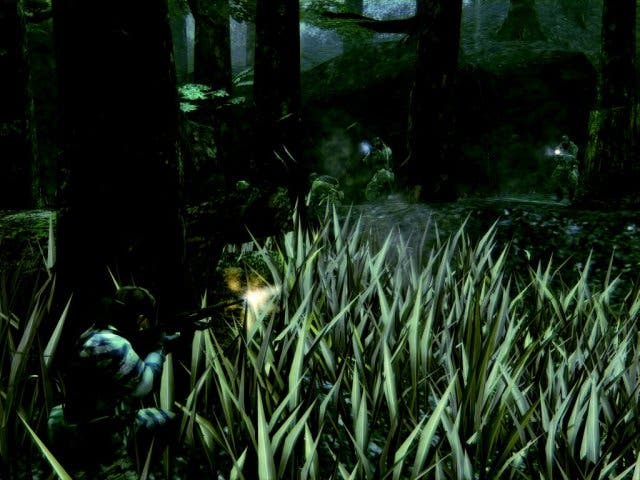
It's at this point that'll you probably ought to swoon at the sight of the reflective water - some of the nicest we've seen on the PS2 - but in truth you won't because MGS3 will have already set a high watermark for visual quality in the preceding sections. Far apart from the fact that more or less all the environments are lushly detailed and imagined - the factory, research facility, encampments, jungle during night and day, and much more besides later on - the character animation is another step forward. The title screen makes the point pretty aptly; much as you used to delight in tweaking Mario's nose and pulling on his ears when you first got hold of an N64, here you can speed up, slow down and colourise a silhouetted Snake as he grabs an enemy's arm, twists it and throws him over his leg to the ground, or disarms him in the process, or any of a number of variations on the CQC techniques you'll come to love. It's the same animation.and modelling that gives way to such believable action shots. Not to mention the other sequences. Lip-synching may be poor due to the translation, but the character models are extremely emotive, managing to convey trust, distrust, warmth, bitterness, envy and virtually everything else - even love. They may struggle with laughter, but that's only a problem once. The Boss, Snake's mentor, is a perfect example - she's a wonderfully designed model with a weathered, motherly look to her face that reflects her paternal role in Snake's development, dressed in one of the most flamboyant but distinctive sneaking suits we can remember.
Frustratingly though, we couldn't possibly mention the most beautiful sight in the entire game, because it would spoil one of the most memorable sequences. So let's get back to what we were already discussing: the various scenarios into which Snake is thrust. Okay petal?
Without giving too much away, there's nearly as much to do inside buildings as there is outside; MGS3 doesn't affect a total upheaval after a couple of hours ala Sons of Liberty, but it does vary the pace, your objectives, and the style of your jungle playground, whether floral or concrete. As we said, playing MGS3 can feel superfluous to the meandering narrative, but with training you'll have just as much fun playing with the mechanics as you did playing with the physics in Half-Life 2. All right, maybe not quite that much fun, but channelling HL2 will probably make you more receptive...
Snake tales
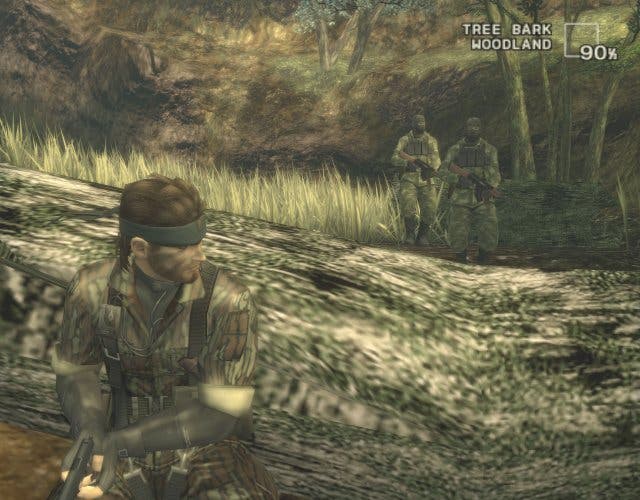
And, hopefully, it'll soften you up for the inevitable discussion of the story. Oh no, we're just as surprised as you are that we got this far without getting into it, but we can fight it no longer - and frankly we wouldn't want to fight it. Everyone in this game could break our arms with their teeth. In any event, the crucial thing here is to convince you that it's as integral and resonant as the storyline of the original Metal Gear Solid without resorting to unmasking some of its best tricks. Hrm. Would you just take our word for it?
Probably not. Okay then. The gist of it you've already heard. But obviously this is just a fraction of what you can expect; to tell you what goes wrong, and what subsequently happens to certain characters, would be criminal. To begin with though, Snake's trying to extract a defecting Russian scientist who is working on a weapon that could put tears on the face of the Earth (presumably by melting the polar icecaps), and he's backed up by an English-born Major, who plays the role Roy Campbell enjoyed in MGS1 and 2, and a support team who keep in touch via radio - a system that bears an uncanny resemblance to MGS1 and 2's much maligned codec system. However in this case the 'codec' takes a back seat. The game drowns you in radio chatter early on - something which compounds the sense of frustration you'll feel over the first three or four hours if you haven't got to grips with the jungle mechanics - but refreshingly the volume of banter lessens considerably as the game goes on, so much so that you sometimes pull the blasted thing up by yourself just to check they're still there, or what your current objective happens to be. Not having it shoved down your throat once every five minutes adds to the sense of isolation and, well, makes you feel more like a spy.
Codec confessions aside, before long, inevitably, things take a turn for the worse, and even by Snake's lofty standards it's a cataclysmic failure. The Boss becomes more than a face on the codec, and you become the only answer to an internal Russian power struggle that could see a deranged soldier named Volgin use his influence and army of scientists to kick off a third world war. You also come into contact with a young, fair-haired GRU soldier named Ocelot. And there's a nuclear explosion.
Snake charmer
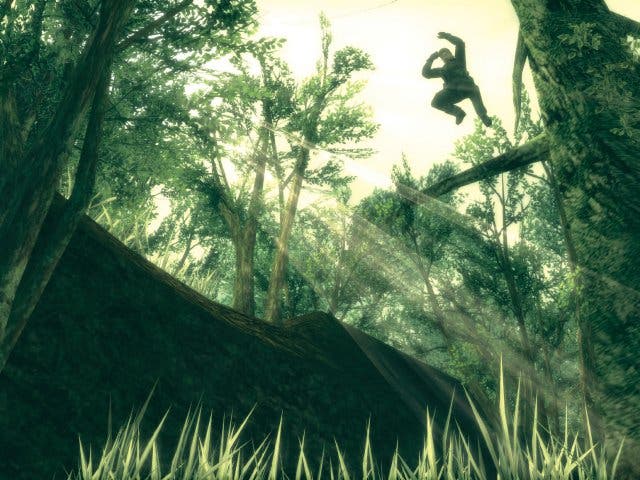
The triumph here is that fans and newcomers alike will become enthralled with the characters and the chain of events that encapsulate them. There are so many standout events and roles, the voice acting is almost uniformly superb (particularly Boss, Snake, Ocelot and Volgin, while there are some distinctly memorable bit-parts in there too), and the quality of the action sequences - directed in-engine - exceeds that of either MGS2 or the GameCube's "Twin Snakes" remake of the original game. The development of Ocelot - heavily influenced by and bitter, recurring rival of our hero - is handled particularly well, and he's one of the stars right up to the final moments. Indeed, the sequence when you first meet him is probably one of the finest in the game, touching on everything from military technobabble (which is still strangely satisfying, even if it's all a bit Tom Clancy) and Russian politics to hand-to-hand combat, shootouts and hostage-taking.
However the real revelation is probably the three-way relationship involving Snake, The Boss, and KGB spy and unlikely ally EVA. While the dialogue is sometimes guilty of labouring over one too many sanctimonious platitudes about what it is to "be a soldier" (presumably it's less hackneyed in Japan where they have about 50 different words for "honour"), the romantic enlightenment, sense of humour and palpable channels of affection are admirably layered to keep you interested. It is deliberately like watching a James Bond film - one of the good ones - where the action is not quite outrageous, and everything's just believable enough for you to empathise. Everything feels like it's actually happening, rather than being directed - even the shifts in location. And we challenge you not to mourn the passing of a particular central character as the credits fade to black.
Key to sustaining your interest is the sense that there are secrets and ambiguities that remain unexplained even when you appear to be looking at a very transparent version of the truth. Konami wisely never lets on completely. You could argue that the narrative twists and turns a little too much in the tail - and trying to comprehend it all as you roll back into the beanbag after the end credits can be dizzying - but the plot itself is far closer to the simple, evocative nuclear fears of the original MGS than the confusing VR nightmare of MGS2, and frankly you can forgive it an over-extensive denouement when it manages to deliver entertainment and closure. We didn't want it to end anyway. You could also argue that some of the humour falls a bit flat, but then for every gag that involves Snake leering at EVA's chest (the new "press R1 for first-person view in cut-scenes" function is hit and miss, although like everything it does have its moments) there's Bond-like pseudo-slapstick and sharp-tongued comebacks, and the sight of a naked Raiden in a thong being shoved in a locker. We'll say no more. Suffice to say, if you enjoy having your head volleyed back and forth over the Iron Curtain by director and scriptwriter Hideo Kojima, you will appreciate this as a whole.
Eaten
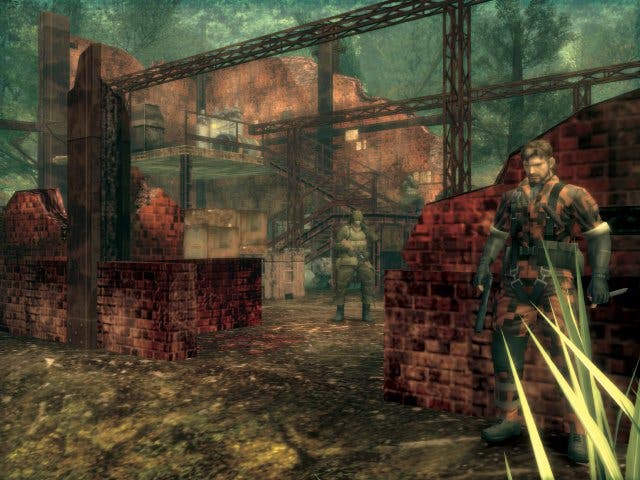
The real question, for us at least, is whether Metal Gear Solid 3 is ultimately an enjoyable James Bond clone (it deserves more respect than the word "clone" implies, actually, but hey ho we're running short of time) with a detachable gameplay component, or whether the two are as intertwined as the developer intended. There are certainly signs that the union is working - the most significant of which is the boss fights, ever a highlight of the MGS series. The various enemies you face in these showdowns are definitely superior to those in MGS2, although none can really top the first game's Psycho Mantis for sheer inventiveness. Without giving too much away though, one particular jungle sniper showdown is so flexible with so many possible outcomes that it's a posterchild for the point we've been trying to make: playing the game is as involving as you're prepared to make it, but the cinematic pay-off is never in doubt. Konami has done much more to unite the storytelling and games-playing than previously. To put it into a context that you'll be able to understand: if someone had to die at Snake's hands, Konami would make you pull the trigger. That's how they make you a part of it. Yet, still, the answer to the original question is probably the less heartening of the two. As we've said all along, you can divorce your own involvement from the fun of the next instalment of Storytime With Hideo; the difference between enjoying MGS3 and giving up on it will be whether you want to get to grips with it properly.
And sadly, as you've probably guessed by doing the "review math" based on what-we've-said-versus-the-score, there are a number of things that do conspire to strip you of your interest. Impressions after three or four hours, not just from ourselves but from everybody we know who's played it, were fairly negative. Some of that's down to the lack of tutelage in the finer arts of MGS3, which is a solvable issue, but it's compounded by the slow start to the story, and a control and camera system that feels decidedly awkward here in 2004. The controls could be fine, but they need further refinement; there are still so many instances where you aim to go from prone position to upright and wind up in the middle stance, only to go prone again automatically as you try to run away (especially unhelpful when you're running away from AK-toting goons), or you accidentally lean up against a wall thus turning 180 degrees (again, usually when it's most advantageous to the opposition for you to switch to first-person mode and then realise you've done a complete about-face in the split-second prior). By the end of the game - and with experience of past MGS titles - you won't be having too many problems, but that's no excuse.
Slow dance

Another concern is that you spend so much time lying around waiting for the insanely slow-moving guards to toil past you on their patrol routes; another thing that severely frustrates you during the opening couple of hours as you're getting to grips with the camouflage system. And fortunately or unfortunately - depending on how you look at it - there is a sense once you do get used to things that CQC is too powerful, and too good at getting you out of situations that ought to strike fear into your heart. When that alert sound kicks off and the guards come looking for you, your first reaction should be evasion rather than confrontation, but a decent handle on CQC means you probably won't have to, even on the Normal difficulty level, and you can clear them and their reinforcements out and move on without too much trouble.
As you can probably tell though, overall it's the pacing that we feel is an issue. The early hours of the game aren't interactive enough, the weighting of the conversation may be necessary but gets tiresome, and your introduction to the game's many changes isn't handled with enough clarity; perhaps Kojima's love of narrative ambiguity is rubbing off in the wrong places? Perhaps the best example of the early poor pacing though is the lack of boss fights over the first few hours. They are undoubtedly worth the wait, but after MGS2 divided opinion we can imagine there are plenty of people out there who will rent the game and make their decision before they even get to grips with the cast of bad guys. Even more maddeningly, in all the time it takes to warm them up the boss characters themselves are barely given a mention. You see them all in a chopper at one point, but there's no Fortune-style bullets-peel-away scene-setting cinematic ala MGS2 for more or less any of them, which is a serious oversight.
Solid
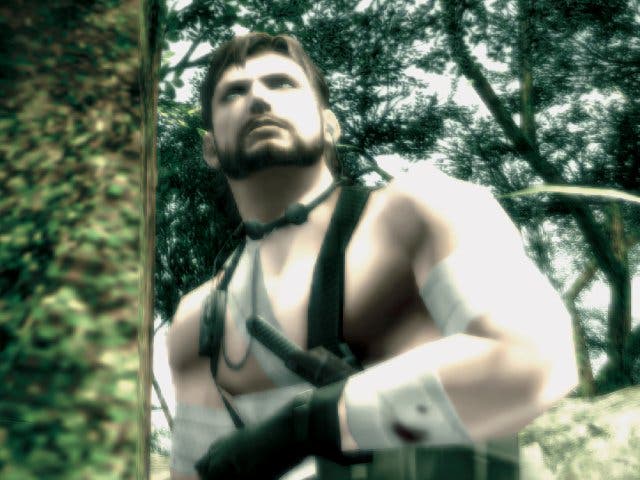
Even so, Kojima has made some absolutely serene directorial decisions (just you wait for the final battle), and, at least in narrative terms, has crafted an affecting, memorable adventure full of empathetic characters in a setting and circumstance that, apart from just giving us an insight into Metal Gear's formative years, subtly balances the black-and-white heroes and villains of the James Bond films he aspires to against the innumerable shades of grey that colour the vast conspiracies that we've always envisaged behind the magic of spying. It's longer, too, and far more likely to encourage replay - with a quirky and slightly inexplicable Ape Escape tie-in "catch the monkeys" mode thrown in for good measure (and with some hilarious codec sequences designed to amuse fans of both series), alongside the bonus items you get to keep at the end of the game for next time through. Meanwhile the gameplay has moved in new directions and it can be as functional or as varied as you want, with several degrees of difficulty to opt for too, but for us the key point here - and the reason we felt so compelled to finish the game before writing about it - is the reason we'd argue that MGS3 is overwhelmingly superior to MGS2: Sons of Liberty:
Even as the credits scroll up the screen, the game is still waiting to spring another surprise on you, as it always is, but the crucial difference between the storytelling of Metal Gear Solids 2 and 3 is that in the jungle you always genuinely think you know what's going on, only to have your interpretation turned upside down five minutes later. That's what we loved about playing Metal Gear Solid all those years ago on the PlayStation. On that basis, if you lose yourself in the jungle you'll find the experience is comparable to Shadow Moses. High praise. Only poor pacing early on, a frustrating mechanical legacy and a sense that Konami still hasn't quite cracked the union of storytelling and gameplay prevent this scoring higher. Still, it may not be a dream this time, but don't be too surprised if it interferes with your sleep patterns.
Order yours now from Simply Games.



